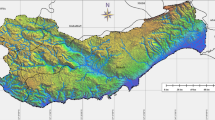Abstract
Typhoon Haitang caused landfall on Taiwan during 15–21 July, 2005 and brought 2,279 mm of maximum cumulative rain with a maximum intensity of 176 mm/h. The torrential rain was mainly distributed from the central mountain range to southern Taiwan and triggered 222 slopeland-related hazards. Among the hazard events, there were 17 debris flows, 157 cases of traffic cut-off, three large-magnitude deep-seated landslides, and 10 villages isolated in the off-track mountainous areas. The debris flows initiated in southern Taiwan were associated with torrential rain, short channel length (<2 km), and small basin area (<3 km2), and were speculated to be induced by flash flood. These flash flood-induced debris flows have a higher rainfall intensity-duration threshold for initiation than in other areas. The deep-seated landslides, isolated villages due to traffic cut-off in off-track mountain areas, and recurrent hazards in areas affected by the ML 7.6 Chi-Chi earthquake in 1999 are characteristics of slopeland hazards in Taiwan in recent years. One of the most urgently needed mitigation strategies in response to slopeland hazards is the plan for enhancing self-rescue disaster resistance in off-track mountainous villages in Taiwan.















Similar content being viewed by others
References
Blair TC (1999) Cause of dominance by sheetflood vs. debris-flow processes on two adjoining alluvial fans, Death Valley, California. Sedimentology 46:1015–1028
Blair TC (2001) Outburst flood sedimentation on the Proglacial Tuttle Canyon alluvial fan, Owens Valley, California, USA. J Sediment Res 71:657–679
Caine N (1980) The rainfall intensity duration control of shallow landslides and debris flows. Geografiska Annaler: Physical Geography (Series A) 62:23–27
Chang KJ, Taboada A, Chan YC (2005) Geologic and morphological study of the Jiufengershan landslide triggered by the Chi-Chi Taiwan earthquake. Geomorphology 71:293–309
Chen H, Petley DN (2005) The impact of landslides and debris flows triggered by Typhoon Mindulle in Taiwan. Q J Eng Geol Hydrogeol 38:301–304
Chen H, Su DI (2001) Geological factors for hazardous debris flow in Hoser, Central Taiwan. Environ Geol 40:1114–1124
Chen H, Su DI, Chen KM (2001) Some case studies on the engineering geological characteristics of debris flows in Taiwan. West Pac Earth Sci 1:265–296
Chen TC, Lin ML, Hung JJ (2003) Pseudostatic analysis of Tsao-Ling rockslide caused by Chi-Chi earthquake. Eng Geol 71:31–47
Chen CY, Chen TC, Yu FC, Hung FY (2004) A landslide dam breach induced debris flow—a case study on downstream hazard areas delineation. Environ Geol 47:91–101
Chen CY, Chen TC, Yu FC, Yu WH, Tseng CC (2005) Rainfall duration and debris-flow initiated studies for real-time monitoring. Environ Geol 47:715–724
Chen CY, Lin LY, Yu FC, Lee CS, Tseng CC, Wang AX, Cheung KW (2007) Improving debris flow monitoring in Taiwan by using high-resolution rainfall products from QPESUMS. Nat Hazards 40:447–461
Cheng JD, Huang YC, Wu HL, Yeh JL, Chang CH (2004) Hydrometeorological and landuse attributes of debris flows and debris floods during typhoon Toraji, July 29–30, 2001 in central Taiwan. J Hydrol 306:161–173
Chigira M, Wang WN, Takahiko FT, Toshitaka KT (2003) Geological causes and geomorphological precursors of the Tsaoling landslide triggered by the 1999 Chi-Chi earthquake, Taiwan. Eng Geol 68:259–273
Glade T, Crozier M, Smith P (2000) Applying probability determination to refine landslide-triggering rainfall thresholds using an empirical antecedent daily rainfall model. Pure Appl Geophys 157:1059–1079
Guadagno FM (1991) Debris flows in the Campanian volcaniclastic soils (Southern Italy). In: Chandler RJ (ed) Proceedings of international conference on slope stability engineering. Isle of Wight, pp 109–114
Hovius N, Stark CP, Chen HT, Lee JC (2000) Supply and removal of sediment in a landslide-dominated mountain belt: Central Range, Taiwan. J Geol 10:73–89
Lin PS, Lin JY, Hung JC, Yang MD (2002) Assessing debris-flow hazard in a watershed in Taiwan. Eng Geol 66:295–313
Shou KJ, Wang CF (2003) Analysis of the Chiufengershan landslide triggered by the 1999 Chi-Chi earthquake in Taiwan. Eng Geol 68:237–250
Wu JH, Wang WN, Chang CS, Wang CL (2005) Effects of strength properties of discontinuities on the unstable lower slope in the Chiu-fen-erh-shan landslide, Taiwan. Eng Geol 78:173–186
Yu FC, Chen TC, Lin ML, Chen CY, Yu WH (2006) Landslides and rainfall characteristics analysis in Taipei City during Typhoon Nari event. Nat Hazards 37:153–167
Yu FC, Chen CY, Lin SC, Lin YQ, Wu SY, Cheung KW (2007) A web-based decision support system for slopeland hazards warning. Environ Monit Assess 127:419–428
Acknowledgments
The authors would like to thank the Agricultural and Forestry Aerial Survey Institute, Central Weather Bureau in Taiwan, the Directorate General of Highways, the National Fire Agency, the Soil and Water Conservation Bureau, the Water Resources Bureau, and the Ministry of Economic Affairs for providing valuable materials for the analysis. The suggestions made by the reviewers were appreciated.
Author information
Authors and Affiliations
Corresponding author
Rights and permissions
About this article
Cite this article
Chien-Yuan, C., Lien-Kuang, C., Fan-Chieh, Y. et al. Characteristics analysis for the flash flood-induced debris flows. Nat Hazards 47, 245–261 (2008). https://doi.org/10.1007/s11069-008-9217-7
Received:
Accepted:
Published:
Issue Date:
DOI: https://doi.org/10.1007/s11069-008-9217-7




